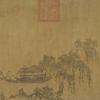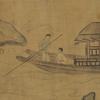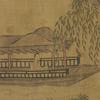




About the Artist
Artwork Story
Translation of “Ma Hezhi’s Spring Boat on the Willow Stream (《柳溪春舫图轴》)” Appreciation with Artistic Nuances
I. Overview and Historical Context
Spring Boat on the Willow Stream (《柳溪春舫图轴》), attributed to the Southern Song artist Ma Hezhi (马和之), is a silk-hanging scroll in light colors (36.7 × 51.4 cm), now housed in the National Palace Museum, Taipei. The painting captures a serene spring scene: willow-draped cliffs, a scholar’s boat drifting on tranquil waters, and a distant dock veiled in mist. While bearing Ma Hezhi’s signature, scholars note discrepancies in brushwork compared to his authenticated works, suggesting it may be a Ming dynasty homage to his iconic “simplified elegance” style. The piece carries multiple collector seals, including those of Zhu Zhichi, Xiang Yuanbian, and the Qianlong Emperor, attesting to its historical reverence.
II. Artistic Analysis: Technique and Aesthetic Philosophy
- Compositional Harmony
The painting employs a “sparse yet layered” structure: the foreground cliff anchors the viewer’s gaze, while the middle-ground boat and distant dock create rhythmic depth. The scholar’s solitary voyage embodies the literati ideal of yinyi (隐逸)—retreat into nature’s tranquility. - Brushwork and Linearity
Ma Hezhi’s signature “willow-leaf描法” manifests in fluid, undulating lines. The cliff is outlined with soft, organic strokes, while water ripples are rendered in fine, parallel threads. Willow branches sway with calligraphic grace, their leaves abbreviated to delicate dots, epitomizing the principle of yi xing xie shen (以形写神)—capturing essence over detail. - Color Palette and Atmosphere
A restrained palette of celadon greens, ochre, and faint azure evokes the “gentle awakening of spring.” The scholar’s crimson robe and the dock’s vermilion accents punctuate the muted tones, symbolizing vitality amidst serenity.


 (c. 1380-1390)-full.webp)
-full.webp)
-full.webp)
-full.webp)
-full.webp)
-full.webp)